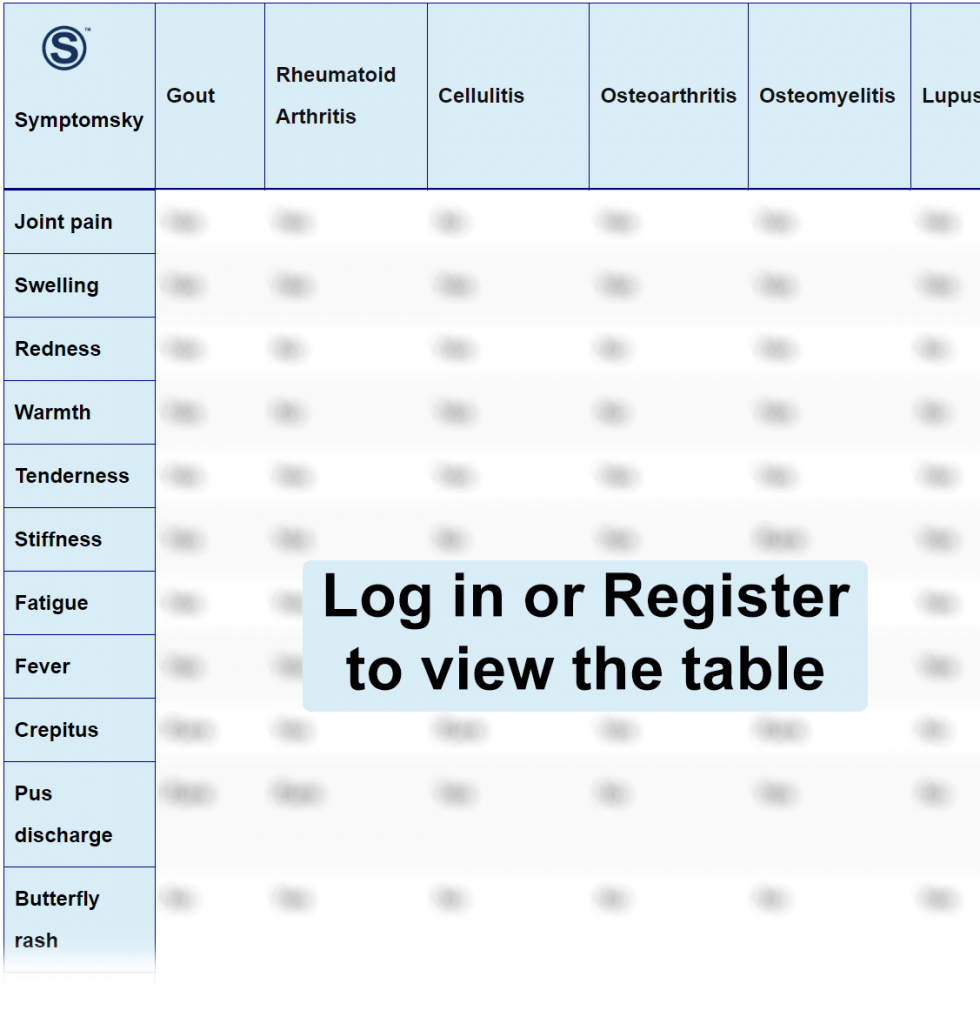Contents
- 1 Gout Differential Diagnosis Table:
- 2 How to Distinguish Gout from Other Diseases
- 2.1 Distinguishing Rheumatoid Arthritis from Gout – Diagnosis
- 2.2 Distinguish Cellulitis from Gout – Diagnosis
- 2.3 Distinguish Osteoarthritis from Gout – Diagnosis
- 2.4 Distinguish Osteomyelitis from Gout – Diagnosis
- 2.5 Distinguish Lupus from Gout – Diagnosis
- 2.6 Distinguish Ankylosing Spondylitis from Gout – Diagnosis
- 2.7 Distinguish Hemarthrosis from Gout – Diagnosis
- 2.8 Distinguish Synovial Sarcoma from Gout – Diagnosis
- 2.9 Distinguish Hypertrophic Osteoarthropathy from Gout – Diagnosis
- 3 Gout Red Flags and Management
Gout Differential Diagnosis Table:

Gout is the deposition of monosodium urate (MSU) monohydrate crystals in tissues, followed by an elevation of uric acid (hyperuricemia) in serum or blood. Gout is characterized by severe, painful swelling in lower extremity joints, which intensifies in the early morning and at night when cortisol levels are low. Joints are tender to touch with localized red inflammation. Systemic features appear as malaise and fever. Gout’s standard diagnosis is through synovial fluid analysis and lab tests.
How to Distinguish Gout from Other Diseases
Distinguishing Rheumatoid Arthritis from Gout – Diagnosis
Rheumatoid arthritis is a chronic autoimmune inflammatory condition.
- Rheumatoid arthritis is characterized by symmetrically inflamed joints, while inflammation in Gout occurs in one or more joints.
- Rheumatoid arthritis has morning stiffness, while Gout pain intensifies in the early morning and night.
- Rheumatoid arthritis is not accompanied by redness or warmth, unlike Gout, which is accompanied by redness and warmth.
“RF (Rheumatoid factor), Anti-CCP, and imaging (MRI, bone scan, and dual-energy X-ray absorptiometry) are used for differentiation.”
Distinguish Cellulitis from Gout – Diagnosis
Cellulitis is an inflammatory skin condition due to bacterial infection in subcutaneous and deep epidermis tissues.
- Cellulitis is a skin condition, while Gout affects joints.
- Cellulitis is characterized by abscess discharge, unlike Gout, which is not associated with abscess discharge.
Distinguish Osteoarthritis from Gout – Diagnosis
Osteoarthritis is a degenerative arthritis affecting joints.
- Osteoarthritis is characterized by morning stiffness for less than 30 minutes, unlike stiffness of gout not associated with time.
- Osteoarthritis is accompanied by crepitus, while Gout is not accompanied by crepitus.
- Osteoarthritis pain starts with activity and resolves with resting, while Gout pain is not related to activity.
“Synovial fluid testing and Imaging (X-ray) are used for differentiation.”
Distinguish Osteomyelitis from Gout – Diagnosis
Osteomyelitis is an inflammatory bacterial or fungal bone infection.
- Osteomyelitis appears as swelling at the site of infection (painful lump), while Gout appears as swelling in joints.
“Blood testing (bacterial infection and C-reactive protein), Bone biopsy, and imaging (technetium-99 scintigraphy and MRI) are used for differentiation.”
Distinguish Lupus from Gout – Diagnosis
Lupus is an autoimmune systemic disease.
- Lupus affects many organs, while Gout affects joints only.
- Lupus is characterized by mucocutaneous signs such as a butterfly rash on the face and discoid patches all over the body, while Gout does not involve mucocutaneous signs on the face or body.
“Immunofluorescence and ANA (anti-nuclear antibodies) laboratory tests are used for confirmation.”
Distinguish Ankylosing Spondylitis from Gout – Diagnosis
Ankylosing spondylitis is an inflammatory chronic disease in axial spine bones and sacroiliac joints (pelvis).
- Ankylosing spondylitis starts from spinal bones manifested as chronic back pain with decreased spinal flexibility, while Gout starts at joints and is not associated with decreased spinal flexibility.
- Ankylosing Spondylitis leads to postural abnormality termed hypokyphosis, while Gout does not affect posture or gait.
“Blood test sample (C-reactive protein and ESR) and imaging (MRI and X-ray) are used for differentiation.”
Distinguish Hemarthrosis from Gout – Diagnosis
Hemarthrosis is a condition of articular joint bleeding due to injury.
- Hemarthrosis pain and swelling occur directly after injury, while Gout is not associated with injury.
- Hemarthrosis causes a painful lump at the site of injury, while Gout does not cause a painful lump.
“Synovial fluid analysis by arthrocentesis and imaging (MRI, CT, and ultrasound) are used for differentiation.”
Distinguish Synovial Sarcoma from Gout – Diagnosis
Synovial sarcoma is a malignant tumor in soft tissues.
- Synovial sarcoma causes a painful lump without swelling, redness, and warmth, while Gout does not cause a painful lump, yet Gout is associated with swelling, redness, and warmth.
“Lesion biopsy and imaging (CT, MRI, and ultrasound) are used for differentiation.”
Distinguish Hypertrophic Osteoarthropathy from Gout – Diagnosis
Hypertrophic Osteoarthropathy is a rare painful condition accompanied by swelling in joints.
- Hypertrophic osteoarthropathy has digital clubbing as a distinctive sign, which is not present in Gout.
“Synovial fluid analysis and Radionuclide bone scanning are used for differentiation.”
Gout Red Flags and Management
Gout complications are bone loss or joint deformity. The objective for treatment is to reduce inflammation and symptoms in the short term and reduce uric acid serum in the long term.
During a Gout attack, pharmacological drugs of choice are NSAIDs, COXII selective inhibitors, colchicine, allopurinol, oral glucocorticoids, etc., in addition to non-pharmacological modifications, which are diet recommendations, limit purine-rich food, and reduce alcohol consumption.
